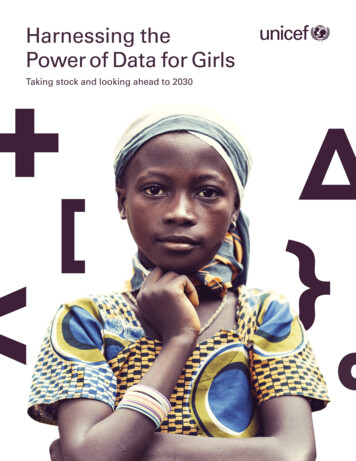
Transcription
Harnessing thePower of Data for GirlsTaking stock and looking ahead to 2030
United Nations Children’s Fund (UNICEF)Division of Data, Research and Policy, October 2016.All reasonable precautions have been taken byUNICEF to verify information contained in thispublication. For corrigenda subsequent to printing,please see data.unicef.org.Permission is required to reproduce any part ofthis publication. Permissions will be freely grantedto educational or non-profit organisations.Please contact:Data and Analytics SectionDivision of Data, Research and Policy3 UN Plaza, New York, NY 10017www.data.unicef.orgdata@unicef.orgSuggested citation: United Nations Children’s Fund,Harnessing the Power of Data for Girls: Taking stockand looking ahead to 2030, UNICEF, New York, 2016.
The 2030 Agenda forSustainable Development sets out anambitious vision for universal progresson urgent issues over the next 15 years.Building on achievements to date, theAgenda commits us to meeting theSustainable Development Goals (SDGs)“for all nations and people and for allsegments of society” and pledges to leaveno one behind. This presents a criticalopportunity to advance the well-being andempowerment of a large segment of theworld population that is at risk of being leftout of global progress: 1.1 billion girls.
CENTRALITY OF GIRLS IN THE SDGSData tell us that the lives of girls today are better in many respects than those of preceding generations.Girls are now more likely to survive childhood, more likely to attend school and complete their education,less likely to be undernourished and less likely to marry as children.Yet girls still suffer significant deprivations and inequalities, many of which result from the persistentgender discrimination faced by girls and women everywhere. And for many girls, further disadvantagebased on disability, location, race, ethnicity or migration status compounds the challenges of buildinga fulfilling future.Achieving the SDGs will not be possible without reaching all girls, starting with the most disadvantaged.For example:Goal 3 calling for good health and well-being for all will not be achieved if adolescentgirls, who currently account for nearly two in three new HIV infections in their age group,are not reached with prevention and treatment options.Goal 4 of inclusive, quality education for all will not be achieved if girls remain notablydisadvantaged in educational access, completion and learning outcomes in a number ofcountries.Goal 5 calling for gender equality and ending all forms of discrimination against girls andwomen will not be achieved if one in four girls still marry in childhood and the practice offemale genital mutilation/cutting (FGM/C) continues unabated in some countries.Goal 16 to promote peaceful and inclusive societies cannot be attained if prevailinggender discrimination and norms in many parts of the world continue to relegate girls to alower status within society and their own families, leaving them vulnerable to exploitationand violence, including trafficking and sexual abuse.Sustainable change for girls and progress towards achieving the SDGs will require investments fromgovernments, donors and development organizations. This includes prioritizing infrastructure, goodsand services that address girls’ vulnerabilities and remove barriers to their empowerment. But it willalso require engagement from communities, social networks, families and girls themselves.Investing in data will be especially critical to monitor SDG progress and ensure accountability, as wellas to increase understanding of girls’ ongoing and emerging challenges and disadvantages as theworld changes between now and 2030.Fulfilling the commitments laid out in the new Agenda will not only improve the lives of today’s1.1 billion girls and support their transition to adulthood; it will also build a better world so the nextgeneration of girls can thrive. The stakes are high, especially since these girls will increasingly be borninto areas of the world where deprivations are especially acute.
The world today is home to1.1 billion girls under age 18.More than half of them live inAsia and a quarter live in Africa.THE SDGGENERATIONNearly nine in 10 girls todaylive in low- and middle-incomecountries – a pattern that isexpected to continue through2030.
70 million girls were born in2015, beginning their lives just asthe world embarks on the SDGs.These girls are expected to live onaverage 73 years. The expected lifespans of girls born in low-incomecountries are almost 20 yearsshorter than those born in highincome countries.Demographic projections indicatethat while most regions will havea similar or smaller number ofgirls by 2030, the number ofAfrican girls will grow by 30 percent between 2015 and 2030.
GIRLS’ CONTINUINGDISADVANTAGESAvailable data suggest that gender disparities in earlychildhood are relatively small for many indicators,including those in the SDGs.Overall, children are equally likely to be registered atbirth irrespective of sex (around 70 per cent). In abouthalf of countries with available data, girls are more likelyto be developmentally on track at ages 3 and 4 thanboys, while in the remaining countries there are no sexdifferences with regards to developmental status, andglobally girls are just as likely as boys to participate inpre-primary education (66 per cent). In most countries,girls and boys are at about equal risk of experiencingviolent punishment by caregivers in the home.This said, however, significant gender differentials persistin some domains and in certain countries. For example,while gender parity in under-5 mortality has beenachieved at the global level, notable gaps persist innine countries — primarily located in South Asia andthe Middle East — where girls’ risk of dying before age5 is significantly higher than would be expected.¹Gender disparities become more pronounced aschildren approach adolescence. The onset of pubertymagnifies biological differences between girls andboys and introduces issues and risks unique to orexacerbated for girls. As shown below, this can resultin adverse outcomes for adolescent girls. 32 million girls are out of school at the primarylevel and 29 million at the lower secondary level.While more than two thirds of countries havereached gender parity in primary education, lessthan half have achieved parity at the secondarylevel. The largest gender gaps are in West andCentral Africa, where 79 girls are enrolled insecondary school for every 100 boys. In three quarters of the low- and middle-incomecountries with available data, more than one infive adolescent girls have experienced violence atthe hands of their partner in the past 12 months.¹ Measuring gender inequalities in under-5 mortality rates (U5MR) is complex. Generally,girls tend to have better biological endowments than boys for survival to age five, andthus higher survival chances under natural circumstances, but sex discrimination canaffect the odds. Gender parity therefore does not mean that girls and boys have anequal risk of dying, rather that the rates are proportionate to biological determinants. Theglobal U5MR is 41 and 44 deaths per 1,000 live births for girls and boys, respectively.
Suicide is the leading cause of death amongadolescent girls aged 15–19 globally, with thehighest rates seen in South-East Asia (one in sixdeaths among adolescent girls). Homicide rates are not as high for girls as for boys,accounting for 30 per cent and 70 per cent ofvictims under age 20, respectively. Perpetratorsdiffer by sex of the victim: globally, almost half (47per cent) of female homicide victims of all agesare killed by family members or intimate partners,whereas the figure for males is 6 per cent. Despite evidence of declines, around one in threegirls aged 15–19 today have undergone FGM/C inthe countries where it is practised. In sub-Saharan Africa, the region most heavilyaffected by HIV, three in four newly infectedadolescents aged 15–19 are girls. Worldwide, almost 750 million women and girlsalive today were married before their 18th birthday.While there has been a decrease in child marriageglobally, progress has not been equitable; highlevels have persisted among the poorest whiledeclines have been limited to the richest. In the least developed countries, over one in fouryoung women aged 20–24 – around 12 millionwomen – have had a live birth before age 18. Similarproportions are observed in sub-Saharan Africa. Globally, less than 40 per cent of pregnantadolescent girls (younger than 20) have their firstantenatal care visit within the first trimester asrecommended. In sub-Saharan Africa and SouthAsia, half of births to adolescent mothers are notattended by skilled health personnel. Nine in 10 people worldwide use improved drinkingwater sources, including nearly six in 10 who usewater piped on premises. In households withouta water source on premises, girls and women arethose primarily responsible for water collection. Insub-Saharan Africa, one round trip to collect watertakes around 33 minutes on average in rural areasand 25 minutes in urban areas. This is time thatcould be spent on productive or leisure activities.Water collection often results in injuries, especiallyto young girls and pregnant women; it can alsoexpose girls to risks of sexual violence whiletravelling back and forth.
550 14MILLION HOURS / DAYHOURS / WEEKGlobally, girls aged 5–14 spend 550 million hours everyday on household chores, 160 million more hoursthan boys their age spend. A girl aged 5–9 spends anaverage of almost four hours per week on householdchores while older girls aged 10–14 spend around ninehours per week on these activities. In some regions andcountries, these numbers are twice as high.In the three countries with the highestprevalence of involvement in householdchores, on average, more than half of girlsaged 5–14 spend at least 14 hours per week,or at least two hours per day, on householdchores (Somalia 64 per cent, Ethiopia 56per cent and Rwanda 48 per cent).50 2/3% MORE TIME SPENTON CHORES THAN BOYSCOOK AND CLEAN IN THE HOMEWorldwide, girls aged 5–9 and 10–14 spend,respectively, 30 per cent and 50 per cent more oftheir time helping around the house than boysof the same age. In some regions, the genderdisparities can be even more severe: In theMiddle East and North Africa and South Asiaregions, girls aged 5–14 spend nearly twice asmany hours per week on household chores asboys of the same age.In countries with available data on chores by type,almost two thirds of girls aged 5–14 (64 per cent)help with cooking or cleaning the house. Thesecond most commonly performed task amonggirls this age is shopping for the household (50 percent), followed by fetching water or firewood (46per cent), washing clothes (45 per cent), caring forother children (43 per cent) and other householdtasks (31 per cent).
GIRLS’ TIME SPENT ON HOUSEHOLD CHORESIt is increasingly acknowledged that the unequal distribution of household chores has negative impacts ongirls’ and women’s lives. Recognizing and valuing time spent on unpaid household services is therefore atarget under SDG 5 on gender equality.Household chores undertaken by children in their own homes within reasonable conditions and hours andunder the supervision of their caregivers or other family members are a normal part of family life and are notalways detrimental to children’s health and well-being.However, the types of chores commonly undertaken by girls – preparing food, cleaning and caring for others– not only set the stage for unequal burdens later in life but can also limit girls’ outlook and potential whilethey are still young. The gendered distribution of chores can socialize girls into thinking that such domesticduties are the only roles girls and women are suited for, curtailing their dreams and narrowing their ambitions.Household chores are usually not valued by the family and community the way income-earning activitiesare, rendering the contributions of girls less visible and less valuable, and having lasting effects on their selfesteem and sense of self-worth.Time spent on chores also limits girls’ chances toenjoy the pleasures and leisure of childhood,including time to play, build social networks and focuson their education. In addition, caring for other childrenor family members who are sick or elderly imposesadult responsibilities on girls while they are stillchildren themselves. Other chores can inadvertentlyplace girls at risk of violence – for instance, whiletravelling to or from their homes to carry water orcollect firewood.To achieve the SDGs, disparities in the burden ofhousehold chores and negative gender patternsmust be addressed before they become cemented inadulthood. Supporting girls to stay in school and beinvolved in sports, play and other leisure and assetbuilding activities – and investing in infrastructure,technology and childcare to ease uneven burdens –can help put girls on the path to empowerment andthe world on course to greater gender equality.
Dataavailabilityfor girlsNational poverty lineMultidimensional povertySocial protection coverageStuntingMalnutritionMaternal mortalitySkilled birth attendanceUnder-5 mortalityNeonatal mortalityHIV infectionsSuicideFamily planning, modern methodsAdolescent birthsCoverage of health servicesCoverage of health insuranceReading and math proficiencyEarly childhood developmentParticipation in pre-primary educationYouth in formal / non-formal educationInformation and communications technology (ICT) skillsGender parity in .4.14.5.1Indicator1.2.1DATAAVAILABILITYFOR GIRLSAccountability for progress during the SDG era will dependon data, yet their availability for two thirds of the SDGindicators relevant to girls is either limited or non-existent;where data do exist, they are not always utilized or madeavailable in user-friendly formats. In some cases, data arenot sufficiently disaggregated or analysed by sex and age.In other cases, there is insufficient data collection on issuesunique to or of critical importance to girls.
Single-sex sanitation facilities in schoolsIntimate partner violenceNon-partner sexual violenceChild marriageFemale genital mutilation / cuttingUnpaid workDecision-making about reproductive healthMobile phone ownershipSafe drinking water servicesSafely managed sanitationYouth not in education, employment or trainingChild .16.2.18.6.18.7.117.8.1 Internet use16.9.1 Birth registration16.3.1 Reporting violence to authorities16.2.3 Sexual violence in childhood16.2.2 Human trafficking16.2.1 Violent discipline16.1.4 Feeling of neighbourhood safety16.1.2 Conflict-related deaths16.1.1 Homicide8.10.2 Possession of a bank accountLiteracy and numeracy4.6.1Legend: Percentage of countries with recent,comparable data available on girls (since 2010) Green 75% of countries Yellow 50 – 74% of countries Red 50% of countries
EXAMPLES OF DATA GAPSEXISTING DATA TOOLS LEAVE GAPS IN MEASUREMENT:Contraceptive use: No data are available on contraceptive use by girls who are neither married nor in a union.Adolescent fertility: Existing data are limited to older adolescents aged 15 and above, missing the populationof adolescent girls aged 10-14 years.DATA QUALITY HAS KNOWN SHORTCOMINGS, WARRANTING REFINEMENT OF DATACOLLECTION METHODS:Mortality: Strengthening vital registration systems would improve mortality measurement overall and makesex-disaggregated mortality data more robust. Measurement through other sources could also be improvedby including questions on the sex of the deceased child, and when this information is captured (as in mosthousehold surveys), making it public and accessible.Suicide: Existing cause-of-death data show suicide as the number one cause among adolescent girls (15–19)globally. While this has drawn important attention to mental health concerns, it should also prompt furtherinvestigation. Given the often poor quality of cause-of-death data and high rates of violence against girls andwomen – including intimate partner violence, ‘dowry deaths’ and ‘honour’ killings – diligence should be takento ensure that femicides are not being misreported as suicides.GENDER-SENSITIVE MEASUREMENT STANDARDS ARE NEEDED:Child labour: In 2008, the 18th International Conference of Labour Statisticians (ICLS) adopted a Resolutionrecognizing, for the first time, the need to account for children’s involvement in hazardous unpaid householdservices (defined in part by long/excessive hours relative to a child’s age) in defining child labour. While childrenaged 5–11 and 12–14 are considered child labourers when they engage in economic activities for at least1 hour and 14 hours per week, respectively, the standard practice has been to consider only those children aged5–14 engaged in household chores for 28 hours or more per week as child labourers. Under this definition, a5-year-old child working in economic activities for one hour per week, for example, would be counted as a childlabourer and considered in need of protection, while a child of the same age could be doing household choresfor up to 27 hours per week (or just under 4 hours a day) and not be afforded the same recognition. This hasthe potential to introduce gender bias since, in many places, more girls than boys do household chores (whileboys are more likely to engage in economic activities). This not only means that girls may be underrepresentedin overall child labour prevalence estimates but also reinforces social norms that undervalue girls’ and women’scontributions and time spent on housework.METHODOLOGICAL WORK ON ADDITIONAL ISSUES RELEVANT TO GIRLS IS ONGOING:Menstrual hygiene management: Data are scarce on the main barriers faced by girls to manage their periodhygienically and with dignity. Relevant questions are currently being incorporated into household surveys witha focus on a private place to wash and change, and the availability of materials and their disposal.Mental health: New tools are being developed to capture mental health issues across cultures and contexts.
HOW TO IMPROVE DATA FOR GIRLSEnhance national capacity and systems to collect, analyse anddisseminate gender data across the age spectrum to improvethe quality and availability of statistics on priority issues for girls.Particular investment is needed in civil registration and vital statisticsthat underpin essential statistics for girls, including sex ratios, mortalityrates and causes of death, birth registration and child marriage.Ensure that data collection tools are gender-sensitive, that indicatorsare gender-relevant and that data are gender-disaggregated.Disaggregate data along other dimensions (e.g., ethnicity, age, wealth,disability, location, migration status) to better understand exactly whichgirls are most disadvantaged.Improve data collection efforts for often-undercounted groups ofgirls, including those living in institutional settings and those whoare displaced.Develop international standards and data collection tools for emergingareas of importance for girls, so that relevant, robust and comparabledata can be produced.Foster the in-depth analysis and wide dissemination of gender statistics.Develop protocols for ethical and safe data collection on sensitive issuesto protect girls from possible harm deriving from their involvement indata gathering.Equip policy-makers with data that is actionable so they can makeevidence-based decisions.
Data sources:UNICEF global databases 2016, based on Multiple Indicator Cluster Surveys (MICS), Demographic and Health Surveys (DHS), censuses,vital registration and other nationally representative sources; under-5 mortality data from the United Nations Interagency Group for ChildMortality Estimation; HIV data from UNAIDS 2014 HIV and AIDS estimates, July 2015; water and sanitation data from the World HealthOrganization (WHO)/UNICEF Joint Monitoring Programme for Water Supply and Sanitation; cause-of-death data from WHO GlobalHealth Estimates; homicide perpetrator data from the United Nations Office on Drugs and Crime; education data from UNICEF and theUnited Nations Educational, Scientific and Cultural Organization (UNESCO) Institute for Statistics; demographic data from United Nations,Department of Economic and Social Affairs, Population Division, World Population Prospects: The 2015 revision, DVD edition, 2015.
Design:Photo credits:Cover: UNICEF/UNI150486/AsselinPg 8: UNICEF/UNI182593/PirozziPg 4: UNICEF/UN028849/ TremeauPg 11: UNICEF/UNI178051/DolanPg 6: UNICEF/UNI111946/AsselinPg 15: UNICEF/UN034302/ TorgovnikPg 7: UNICEF/UNI74901/PirozziPg 16: UNICEF/UNI10369/Estey UNICEF/UNI74905/PirozziPg 18: UNICEF/UNI43999/PirozziCamila Garay
UNICEF Data and Analytics Section Division of Data, Research and Policy 3 UN Plaza, New York, NY 10017 data.unicef.org
world changes between now and 2030. Fulfilling the commitments laid out in the new Agenda will not only improve the lives of today's 1.1 billion girls and support their transition to adulthood; it will also build a better world so the next generation of girls can thrive. The stakes are high, especially since these girls will increasingly be born











